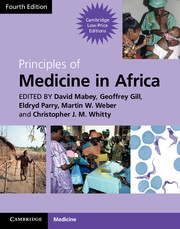Book contents
- Frontmatter
- Contents
- Contributors
- Foreword
- Section 1 Health and disease
- Section 2 Mother and child health
- Section 3 Infection: general principles
- Section 4 Major common infections
- Section 5 Bacterial infections
- 22 Typhoid, paratyphoid and non-typhoid Salmonella infections
- 23 Streptococcus pyogenes and Staphylococcus aureus
- 24 Rickettsial infections
- 25 Brucellosis
- 26 Leptospirosis
- 27 Relapsing fever
- 28 Plague
- 29 Anthrax
- 30 Tetanus
- 31 Diphtheria
- 32 Leprosy
- 33 Cholera
- Section 6 Viral Infections
- Section 7 Protozoal infections
- Section 8 Helminth infections
- Section 9 Fungal infections
- Section 10 Non-communicable diseases
- Section 11 Diseases of body systems
- Section 12 Cancer and Palliative Care
- Section 13 Venoms and Poisons
- Index
- References
24 - Rickettsial infections
from Section 5 - Bacterial infections
Published online by Cambridge University Press: 05 March 2013
- Frontmatter
- Contents
- Contributors
- Foreword
- Section 1 Health and disease
- Section 2 Mother and child health
- Section 3 Infection: general principles
- Section 4 Major common infections
- Section 5 Bacterial infections
- 22 Typhoid, paratyphoid and non-typhoid Salmonella infections
- 23 Streptococcus pyogenes and Staphylococcus aureus
- 24 Rickettsial infections
- 25 Brucellosis
- 26 Leptospirosis
- 27 Relapsing fever
- 28 Plague
- 29 Anthrax
- 30 Tetanus
- 31 Diphtheria
- 32 Leprosy
- 33 Cholera
- Section 6 Viral Infections
- Section 7 Protozoal infections
- Section 8 Helminth infections
- Section 9 Fungal infections
- Section 10 Non-communicable diseases
- Section 11 Diseases of body systems
- Section 12 Cancer and Palliative Care
- Section 13 Venoms and Poisons
- Index
- References
Summary
The problem in Africa
Rickettsioses are among the oldest recognized infectious diseases, and much of the current world-wide burden is in Africa, with some diseases unique to Africa. Sensu stricto are caused by representatives of Rickettsiaceae family of the same name order of α-proteobacteria. However, a number of pathogenic bacteria traditionally considered rickettsia were reclassified in another family (Ehrlichia and Anaplasma; Anaplasmataceae), order (Bartonella) and, even, in γ-proteobacteria (Coxiella burnetii). Nevertheless, despite reclassification, ehrlichoses, anaplasmoses, bartonelloses and Q fever are still described together with rickettsioses such as the spotted fever and typhus groups. Here we also describe these diseases, which occur in various parts of Africa.
New species in the Rickettsia genus are regularly described, and some of them have been shown to play a role in human pathology. For the moment, 28 rickettsial species and subspecies are associated with human pathology with only 5 rickettsioses described before 1991 (Parola et al., 2005; Renvoisé, et al., 2009). Many of them were first identified in Africa, including the notorious Rickettsia africae, the agent of African tick-bite fever, probably the most important of these diseases on the continent.
The organisms
Rickettsiae are small (0.3–0.5 x 0.8–2.0 mm), Gram-negative, aerobic coccobacilli which retain basic fuchsin when stained by the method of Gimenez (Parola et al., 2005). All species of the family Rickettsiaceae (genera Rickettsia and Orientia) reside free in the cytoplasm of host cells and not enclosed in a vacuole. Rickettsiae of the spotted fever group may also reside in the nucleus of the eukaryotic host cells.
- Type
- Chapter
- Information
- Principles of Medicine in Africa , pp. 322 - 329Publisher: Cambridge University PressPrint publication year: 2013



